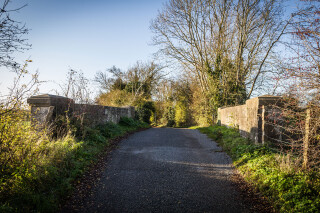St Andrew’s Lane bridge at Congham, Norfolk was infilled by the state-owned roads company in the spring of 2021, 17 months after telling the Borough Council of King’s Lynn & West Norfolk that the project would be carried out under permitted development rights intended for immediate temporary works in emergency situations. Costing £127,000 it is estimated to have involved more than a thousand tonnes of stone and concrete.
It should be no business of National Highways – the bridge carries a local authority lane over a long-gone railway line – but when British Rail was broken up and privatised in 1993, responsibility for these sort of redundant structures reverted to the Department for Transport, which gave its highways engineers responsibility.
In October 2019, National Highways consultants informed planning officers that the structure’s ‘edge girders’ – holding up the parapets – only had a capacity of 7.5 tonnes, but did not mention that the girders supporting the actual carriageway had been assessed as having a 40-tonne capacity in 2003. No evidence of an emergency was provided, say opponents to the bridge infilling programme that has been going on around the UK.
To comply with its obligations under permitted development rights known as ‘Class Q’, National Highways should have asked the council for written consent if it wanted to keep the infill longer than 12 months. Its failure to do so resulted in the scheme becoming unauthorised and the council demanded that retrospective planning permission be sought.
Graeme Bickerdike, a member of The HRE Group of engineers, greenway developers and heritage campaigners campaigning on the issue, said: “The bridge had defects typical of most legacy structures and presented only modest risks given the prevailing circumstances. The action taken by National Highways was characteristically disproportionate.
“They infilled the structure for routine asset management purposes, but chose to exploit rights that apply to urgent, short-term interventions. The scheme was part of a programme of more than a hundred bridge infills, with almost one-third of them being proposed under these misapplied emergency rights. Some of the structures had no meaningful defects.”
Dating from 1926, St Andrew’s Lane bridge was one of six built using an early system of modular concrete components developed by William Marriott, engineer of the Midland & Great Northern Joint Railway. Only two of the six structures survive following the infilling.
![How it used to look [©Richard Humphrey] How it used to look [©Richard Humphrey]](https://www.theconstructionindex.co.uk/img-cache/a12f885e908de57fd536389593f5354c/320x213.4375_1684740250_conghambridgebeforerichardhumphrey.jpg)
“The historical significance of the bridge wasn’t considered by National Highways when it decided to undertake this destructive burial”, said Graeme Bickerdike. “Nor did it take into account the unwelcome environmental impacts of transporting a large amount of quarried material and placing it in a rural landscape, or the structure’s potential to play a useful role as we transition to a greener future.

“In its planning application, National Highways claims the infill ‘barely alters…the perception and enjoyment of the bridge’ which is now ‘preserved within the infilling for posterity’. This demonstrates just how clueless they are when it comes to heritage; they simply do not understand their responsibilities as custodians of legacy assets.”
The infill scheme at Congham was one of five involving breaches of Class Q rights by National Highways between autumn 2019 and spring 2021. The submission of another retrospective planning application – for a project at Rudgate bridge near Tadcaster, North Yorkshire – is expected in late June.
National Highways has until 11th October to unearth a disused railway bridge at Great Musgrave in Cumbria after councillors rejected a retrospective planning application for its infilling. The scheme was pursued under Class Q rights after National Highways’ engineer rejected Eden District Council’s request not to start the work.
National Highways’ head of the Historical Railways Estate programme, Hélène Rossiter, said: “Congham Road Bridge was infilled in February 2021 because we viewed it as a public safety risk. When we took over management of the bridge it was in a very poor condition and had started moving. Previous repairs conducted by our predecessor were failing as a result of this movement, suggesting that further repair would not resolve the issues.
“We consulted with the local planning and highway authorities beforehand, and they confirmed they had no objection to the works and that the scheme didn’t impact any of their active travel plans.
“We have been in touch with the King’s Lynn & West Norfolk Borough Council, the local planning authority for the bridge, to ensure that there are no plans for active travel or heritage railway that would be prevented by infilling the bridge. We’re in regular dialogue and welcome scrutiny.
“A retrospective planning application to retain the infill has been submitted and we can provide further comment once that process concludes.”
Got a story? Email news@theconstructionindex.co.uk

![St Andrew’s Lane bridge in Congham has been filled in with concrete [Photo ©The HRE Group]](/img-cache/a12f885e908de57fd536389593f5354c/750x500_top_1684740222_conghamaerialthehregroup.jpg)


